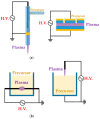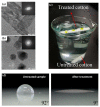A Review of Plasma Synthesis Methods for Polymer Films and Nanoparticles under Atmospheric Pressure Conditions
- PMID: 34301024
- PMCID: PMC8309454
- DOI: 10.3390/polym13142267
A Review of Plasma Synthesis Methods for Polymer Films and Nanoparticles under Atmospheric Pressure Conditions
Abstract
In this paper, we present an overview of recent approaches in the gas/aerosol-through-plasma (GATP) and liquid plasma methods for synthesizing polymer films and nanoparticles (NPs) using an atmospheric-pressure plasma (APP) technique. We hope to aid students and researchers starting out in the polymerization field by compiling the most commonly utilized simple plasma synthesis methods, so that they can readily select a method that best suits their needs. Although APP methods are widely employed for polymer synthesis, and there are many related papers for specific applications, reviews that provide comprehensive coverage of the variations of APP methods for polymer synthesis are rarely reported. We introduce and compile over 50 recent papers on various APP polymerization methods that allow us to discuss the existing challenges and future direction of GATP and solution plasma methods under ambient air conditions for large-area and mass nanoparticle production.
Keywords: atmospheric-pressure plasma; nanoparticles; plasma polymerization; polymer films; room temperature growth; solution plasma.
Conflict of interest statement
The authors declare no conflict of interest.
Figures


















Similar articles
-
A new approach for synthesizing plasmonic polymer nanocomposite thin films by combining a gold salt aerosol and an atmospheric pressure low-temperature plasma.Nanotechnology. 2021 Apr 23;32(17):175601. doi: 10.1088/1361-6528/abdd60. Nanotechnology. 2021. PMID: 33470988
-
Ultrafast Room Temperature Synthesis of Porous Polythiophene via Atmospheric Pressure Plasma Polymerization Technique and Its Application to NO2 Gas Sensors.Polymers (Basel). 2021 May 28;13(11):1783. doi: 10.3390/polym13111783. Polymers (Basel). 2021. PMID: 34071654 Free PMC article.
-
Conductive Polymer Synthesis with Single-Crystallinity via a Novel Plasma Polymerization Technique for Gas Sensor Applications.Materials (Basel). 2016 Sep 30;9(10):812. doi: 10.3390/ma9100812. Materials (Basel). 2016. PMID: 28773932 Free PMC article.
-
A Review of Plasma-Synthesized and Plasma Surface-Modified Piezoelectric Polymer Films for Nanogenerators and Sensors.Polymers (Basel). 2024 May 30;16(11):1548. doi: 10.3390/polym16111548. Polymers (Basel). 2024. PMID: 38891493 Free PMC article. Review.
-
Hydrophobic and superhydrophobic surfaces fabricated using atmospheric pressure cold plasma technology: A review.Adv Colloid Interface Sci. 2018 Apr;254:1-21. doi: 10.1016/j.cis.2018.03.009. Epub 2018 Mar 29. Adv Colloid Interface Sci. 2018. PMID: 29636183 Review.
Cited by
-
Strategies for Improved Wettability of Polyetheretherketone (PEEK) Polymers by Non-Equilibrium Plasma Treatment.Polymers (Basel). 2022 Dec 5;14(23):5319. doi: 10.3390/polym14235319. Polymers (Basel). 2022. PMID: 36501716 Free PMC article. Review.
-
Potential Application of Pin-to-Liquid Dielectric Barrier Discharge Structure in Decomposing Aqueous Phosphorus Compounds for Monitoring Water Quality.Materials (Basel). 2021 Dec 9;14(24):7559. doi: 10.3390/ma14247559. Materials (Basel). 2021. PMID: 34947158 Free PMC article.
-
A novel avenue in the successful synthesis of Schiff base macromolecules via innovative plasma and classical approaches.Sci Rep. 2025 Mar 29;15(1):10840. doi: 10.1038/s41598-025-94665-z. Sci Rep. 2025. PMID: 40155415 Free PMC article.
-
Critical review of polymer and hydrogel deposition methods for optical and electrochemical bioanalytical sensors correlated to the sensor's applicability in real samples.Anal Bioanal Chem. 2023 Jan;415(1):83-95. doi: 10.1007/s00216-022-04363-2. Epub 2022 Oct 24. Anal Bioanal Chem. 2023. PMID: 36280625 Free PMC article. Review.
-
Development of an Atmospheric Pressure Plasma Jet Device Using Four-Bore Tubing and Its Applications of In-Liquid Material Decomposition and Solution Plasma Polymerization.Polymers (Basel). 2022 Nov 14;14(22):4917. doi: 10.3390/polym14224917. Polymers (Basel). 2022. PMID: 36433044 Free PMC article.
References
-
- The Plasma Chemistry of Polymer Surfaces: Advanced Techniques for Surface Design. 1st ed. Wiley-VCH; Weinheim, Germany: 2021. Plasma polymerization; pp. 337–375.
-
- de Wilde P. Vermischte mittheilungen. Berichte. 1876;7:352.
-
- Berthelot M. Formation de l’acétylène dans les combustions incomplètes. Ann. Chim. Phys. 1866;9:413.
-
- Berthelot M. Action Réciproque des carbures d’hydrogène. synthèse de styrolène, de la napthaline, de l’anthracéne. Ann. Chim. Phys. 1867;12:5–52.
-
- Thenard P., Thenard A. Acétylène liquéfié et solidifié sous l’influence de l’effluve électrique. Comptes Rendus. 1874;78:219.
Publication types
Grants and funding
LinkOut - more resources
Full Text Sources
Other Literature Sources

